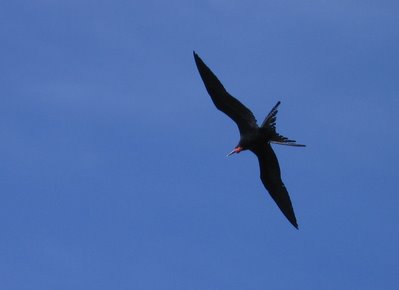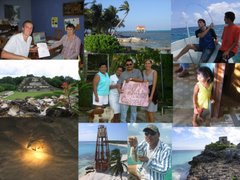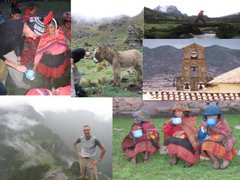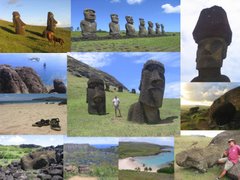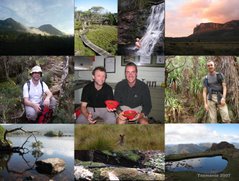 Beautiful water, jungle and mountains of Honduras
Beautiful water, jungle and mountains of Honduras What to say about the Honduras trip?! It was part-joy and part-trial! It’s only fair to mention the positives first as the negatives were pretty much bad luck and misfortune. It’s a beautiful country for starters. Teri and I caught the boat from Punta Gorda in the South of Belize and almost immediately you can see the mountains of Guatemala and Honduras looming up through the
 heat-haze. As the barrier-reef extends right down to the Honduranian coastline, the waters are bright, and flat like a mirror.
heat-haze. As the barrier-reef extends right down to the Honduranian coastline, the waters are bright, and flat like a mirror.Leaving PG
The boat took an hour to Guatemala from where we took a cab another hour to the border with Honduras. After much passport stamping and fee-paying we were on the bus - two gringos loose in the wilds of Spanish-speaking Central America.

"One man went to Omoa..."
Omoa (above) was the first place we stayed. The coastal village has a long history, which must have been transformed when the Spanish arrived, and built a huge fort here in the 15th Century.


Cannons… n ...balls.
From Omoa, we had a couple of long bus rides from Omoa in the North West through to La Ceiba the North East of Honduras. The countryside was all jungle and misty mountainsides. A little into the interior, we had to change buses in San Pedro Sula, the largest city in Honduras, which seems to have a bit of a reputation as a kind-of Bogota of Central America.
 From La Ceiba, we caught the ferry to Roatan. Roatan is quiet, beautiful and laid back but compared to the mainland it seemed touristy. Up to that point, we had seen 6 other gringos in two days in Honduras.
From La Ceiba, we caught the ferry to Roatan. Roatan is quiet, beautiful and laid back but compared to the mainland it seemed touristy. Up to that point, we had seen 6 other gringos in two days in Honduras.And the bad parts? There was obviously something in the air when my 5-hour bus ride from Belize City to Punta Gorda pulled up 20 minutes out of BC with a puncture. I had an ominous feeling after that, and when the bus pulled up again two hours later behind a long queue of traffic, in the dark, in the middle of the hills and jungle I knew there were trouble at mill.

This is the wreck of a fruit-truck that, on Thursday morning, had been heading from Southern Belize to the capital when at about 2.30 in the afternoon it skidded, jacknived and blocked the entire road. When we arrived at 6.30, this was pretty much the scene: a score of blokes throwing grapefruit everywhere. There was nowhere for traffic to pass, but luckily bus drivers on opposite sides of the crash had the great idea of swapping passengers and then turning back (there is only one road from the capital to the very south of the country) to where they started, so I still got to PG that night, about 8 hours after setting out…

It’s always best to make the most out of adversity. I nabbed a grapefruit and smuggled it through Guatemala and into Honduras where Teri and I had it for breakfast on Friday morning.
 Fledgling airline Air Honduras suddenly realises the impracticality of spending its entire aircraft budget on glamorous air-hostesses…
Fledgling airline Air Honduras suddenly realises the impracticality of spending its entire aircraft budget on glamorous air-hostesses…All in all, it took about 8 hours by coach, then an hour by boat, an hour in a cab, two plus one plus four hours in another 3 buses and then an hour by catamaran to get to Roatan. Faced with this return trip and dicky tummies, we opted for the luxury of flying back to Belize. In comparison with buses and boats, even three flights in a tiny plane with a two hour delay in the middle was little to gripe about, though we were a bit miffed when we were moved from the back of the plane to the front, to help ‘balance things up’. Best not to argue with pilots or aircraft mechanics though, I find.
All that was nothing though, compared to the big trauma of the weekend – food poisoning! I don't know whether it was the food or the water, but i was on my back (or more often in the loo) for the whole of Saturday and didn't eat anything for 36 hours (very, very unlike me). Teri was then sick too, just as i was getting better. Our big plans for jungle walks and exploring had to be ditched, but at least where we were staying had a beautiful beach to flake out on.
 "Teri, I think there's only one solution for my problem...", "Don't worry Calum, I've found it already..." The Honduranian over-the-counter remedy for the runs.
"Teri, I think there's only one solution for my problem...", "Don't worry Calum, I've found it already..." The Honduranian over-the-counter remedy for the runs.In that last day I somehow also managed to lose my bankcard (machine at the airport ate it) and my sunglasses (don’t even know where I lost those). I just can’t cope with a 4am start… It was almost a relief to get back to the relative safety of Belize City, where there had been just four shootings since I'd left the previous Thursday.








 On the Friday night I went to see the Nutcracker - Belizian style - at the national concert hall. Great fun, with some amazing outfits and a mix of classical, reggae and Punta-Rock numbers! Top tip - chucking a hundred kids into the cast guarantees a big audience of friends and family…
On the Friday night I went to see the Nutcracker - Belizian style - at the national concert hall. Great fun, with some amazing outfits and a mix of classical, reggae and Punta-Rock numbers! Top tip - chucking a hundred kids into the cast guarantees a big audience of friends and family… 








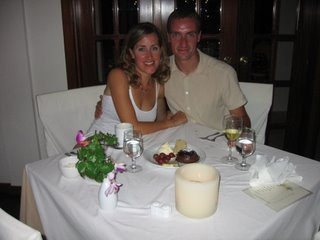
 Three Cayes Trees
Three Cayes Trees

